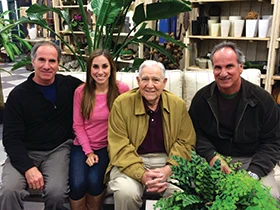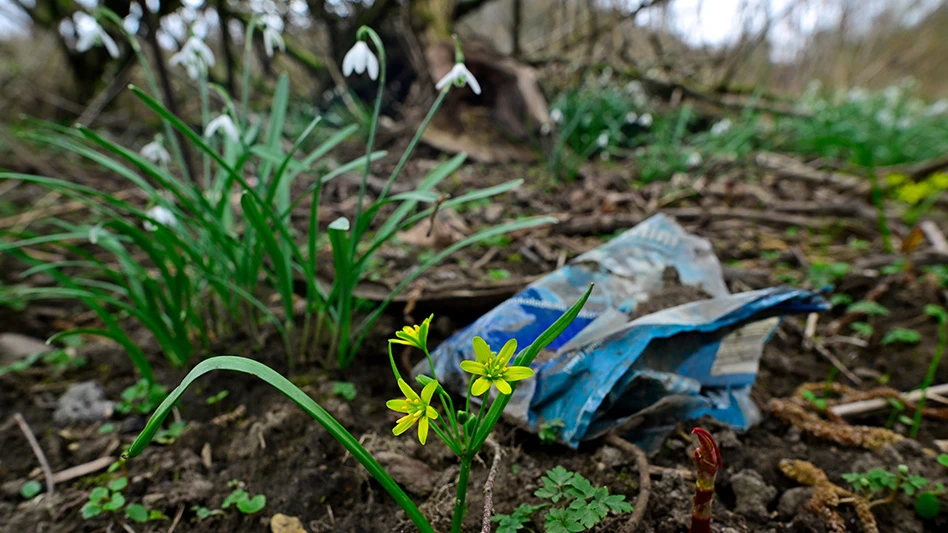
Fleur-de-lis decorations.
 Bright-colored beaded necklaces. “Who dat!” signs. Mardi Gras masks. Perino’s Garden Center’s pride in its New Orleans roots from the moment you walk into the store, set on approximately 3 acres in the suburb of Metairie, Louisiana. Founded nearly 60 years ago by World War II veteran Salvador “Sam” Perino in Metairie, Perino’s is still family-owned and operated. Brothers Sal “Buddy” Perino and Peter Perino run the business, and Megan, one of Buddy’s daughters, came on as operations manager a year and a half ago from an information technology job. Buddy anticipates that four out of the five daughters he and his brother have will eventually become a part of the family business.
Bright-colored beaded necklaces. “Who dat!” signs. Mardi Gras masks. Perino’s Garden Center’s pride in its New Orleans roots from the moment you walk into the store, set on approximately 3 acres in the suburb of Metairie, Louisiana. Founded nearly 60 years ago by World War II veteran Salvador “Sam” Perino in Metairie, Perino’s is still family-owned and operated. Brothers Sal “Buddy” Perino and Peter Perino run the business, and Megan, one of Buddy’s daughters, came on as operations manager a year and a half ago from an information technology job. Buddy anticipates that four out of the five daughters he and his brother have will eventually become a part of the family business.
The business has weathered its share of storms, both literally and figuratively, including Hurricane Katrina in 2005, which closed it for about a month while repairs were made at the retail store and the growing facilities. “There were 19 people living [at my parents’ house] for a week,” Buddy says. “Katrina happened August 29. We opened up October 1, and it was encouraging because we had people coming in the first couple of days who said they’d been driving, living in Baton Rouge, fixing up their house that had flooded here, but they said they did not want to drive up to the house and see everything dead. So they started buying plants from the get go.”
Getting an edge with local grown
 About 45 miles away in the Covington area, Perino’s has two growing facilities, including a greenhouse with 300,000 square feet of production space, and 10 acres of outdoor growing space. About 70 percent of the store’s total green goods supply is grown there, including all of the seasonal color that’s sold in the store. The area around the retail store in Metairie has been developed to the point where expanding the store isn’t an option, nor is keeping large quantities of back stock on the existing site. Having growing facilities nearby offers many advantages, including quick restocking and healthier plants.
About 45 miles away in the Covington area, Perino’s has two growing facilities, including a greenhouse with 300,000 square feet of production space, and 10 acres of outdoor growing space. About 70 percent of the store’s total green goods supply is grown there, including all of the seasonal color that’s sold in the store. The area around the retail store in Metairie has been developed to the point where expanding the store isn’t an option, nor is keeping large quantities of back stock on the existing site. Having growing facilities nearby offers many advantages, including quick restocking and healthier plants.
“We run a truck that has 17 rolling racks and in the spring, we run two of those trucks a day [from the growing facility to the store],” Buddy says. “We’re bringing in anywhere from 30 to 40 rolling racks a day full of seasonal color.” Perino’s is inspired by the grocery store concept of always having full, attractive displays of produce that’s continually being restocked. “People like shopping that way,” Buddy says.
When it comes to producing healthy plants that look their best from the greenhouse to customers’ hands, the fact that most plants travel less than an hour reduces stress as well as freight costs, which can sometimes be as much as the plants themselves when shipped in. Also, in the case of extended cold temperatures and/or freezes, as happened unexpectedly at the end of January, operations manager Megan says that they will send non-cold-tolerant plants back to the greenhouse until the threat has passed, rather than lose the stock. The same goes for plants that are looking sub-par on the shelf. “If anything looks like it’s starting to wilt, we immediately ship it back over to the greenhouse for a little TLC,” Megan says. “We try not to keep anything that’s not in tip-top condition on our shelves.”
 Growing local to alleviate big box pressure
Growing local to alleviate big box pressure
“You can’t say oh no. Big box store’s down the street. I’m not going to make it,” Buddy says. “You can, but I think you have to find your niche first and then always be willing to change and do different things [to survive].” For Perino’s, that niche is growing a high-quality plant that can be sold for a reasonable price. “If a garden center is kind of struggling and they have the wherewithal to borrow some money and open up a little greenhouse range somewhere, whether it’s on their property or somewhere else, I strongly advise it,” he says. “I think it’s a good way to beat the chains.”
But the appearance of big box stores in the last 20 to 30 years hasn’t necessarily been all bad, even though business would be easier without them. “One thing they did was advertise plants,” Buddy says. “They brought so many people into the industry that maybe wouldn’t ordinarily have been in it. Maybe the people that went into the box store to buy a screwdriver or some lumber passed by some nice plants - maybe they never even thought about buying plants before - and said ‘Hey, this is nice.’ Eventually, as they got into the garden, they said, ‘I want some help.’ Then they would come to an independent — I think they’ve kind of helped us in the long run.”
Perino’s is able to capitalize on the “eat/grow local” trend by offering locally grown plants to customers looking to support the area. “With people really pushing the local grown produce, why not plants, too?” Buddy says. “We really try to push that grown local type of concept. You’re seeing that in grocery stores; they’re all promoting that. Why wouldn’t a garden center do the same thing?”
One of the challenges is to get the word out to consumers that not only is buying locally grown plants helping the local economy, but that Perino’s isn’t necessarily more expensive than the neighborhood box store. “Because we’re grower-retailers and we can produce color at a reasonable price and have it supplied here all the time, our spread always looks better and the color prices are the same, if not cheaper, than Lowe’s,” says Buddy. One of the store’s current focuses is on marketing that aspect of their products. Perino’s produces a store brand potting soil and planting mix themselves at the growing facility, deepening their local connection.
|
One of the ways that Perino’s keeps in touch with its roots is through photos and antiques displayed in the store. A portrait of founder Sam Perino in military uniform is hung behind the front register, along with historical photos of the store, adding a personal touch and nod to the store’s long history. In addition, antiques from Sam’s collection, such as gas pumps, stained glass and a classic Coca Cola machine, are incorporated into displays and used as decorations. Wood from an old barn on a nearby family property was repurposed and used to build an eye-catching barn structure in the middle of the store, used to house many gift items, including the popular candle category. *****
As New Orleans continues to develop in the aftermath of Hurricane Katrina and the BP oil spill times, Perino’s is also looking to the future. Buddy Perino says that the garden center will be looking to expand in certain areas to increase the business’ viability and make it sustainable for future generations.
Plant rentals for weddings. “New Orleans has gotten to be one of the hottest wedding destinations,” says Buddy. For that reason, they’re looking into expanding into this category. Simplifying processes. In order to streamline plant sales to contractors, Perino’s is looking at the possibility of developing a system to invoice, process and pick up orders exclusively at the greenhouse property instead of having to have contractors come to the store to process the order. |
Keeping the southern connection
 Customers know they’re in N’awlins when they walk into Perino’s. The fleur-de-lis, a symbol that dates back to the times of French royalty, and one of the official symbols of the state of Louisiana, can be found throughout the store as part of the decorations, displays, statuary and more. In fact, Perino’s current logo uses the iconic symbol as the apostrophe in its name.
Customers know they’re in N’awlins when they walk into Perino’s. The fleur-de-lis, a symbol that dates back to the times of French royalty, and one of the official symbols of the state of Louisiana, can be found throughout the store as part of the decorations, displays, statuary and more. In fact, Perino’s current logo uses the iconic symbol as the apostrophe in its name.
As customers peruse the store, they’ll find tags with “Made in Louisiana” and signs telling the stories behind the local artists whose works they sell. Historic scenes of downtown New Orleans’ Bourbon Street and other local icons are depicted on everything from nightlights to corkscrews, and customers can create their own “street sign” with old-fashioned tiles to look like the ones that used to be prevalent in New Orleans years ago.
Mardi Gras provides an extra holiday between Christmas and spring festivities for the store, although it can cause complications for the store. Parades celebrating the event pass in front of Perino’s, and roads are temporarily closed on several normally busy Saturdays during the season.
Perino’s produces and sells traditional Mardi Gras wreathes and puts together themed displays that include everything from sparkly masks to cookbooks for local cuisine to decorative ribbon rolls to decorated glasses and dishes. The timing of Mardi Gras, combined with the weather, determines in part when people start gardening in the area. According to Buddy, if Mardi Gras is earlier in the season, customers seem to wait until it’s over to start planting. When it occurs later in the season and the weather warms up in early February, people tend to start coming in before Mardi Gras to change out their landscapes.
But whenever locals start gardening, Perino's is ready with fresh, locally grown plants and anything else they may need.
All photos by Karen E.Varga unless otherwise noted

Explore the April 2014 Issue
Check out more from this issue and find your next story to read.
Latest from Garden Center
- Pennsylvania Horticultural Society shares top gardening trends from 2025 Philadelphia Flower Show
- California Spring Trials 2026 dates announced
- Les Evans promoted to DRAMMwater segment manager, Al Zylstra to retire
- Hoffmann Family of Companies to acquire N.G. Heimos Greenhouses
- GIE Media Horticulture Group wins five regional 2025 Azbee Awards of Excellence
- QR Zipper partners with American Floral Endowment on Sustainabloom donations
- VIDEO: How Kansas City garden centers are fostering community
- Pennsylvania Horticultural Society announces 2025 Gold Medal Plant winners
 Remembering its roots
Remembering its roots  Direct, discounted sales to landscapers. After closing down their struggling landscape division in 2004, Perino’s shifted its focus to sell directly to landscapers at a 10 to 25 percent discount. It has quickly become one of the fastest-growing parts of the business.
Direct, discounted sales to landscapers. After closing down their struggling landscape division in 2004, Perino’s shifted its focus to sell directly to landscapers at a 10 to 25 percent discount. It has quickly become one of the fastest-growing parts of the business.




